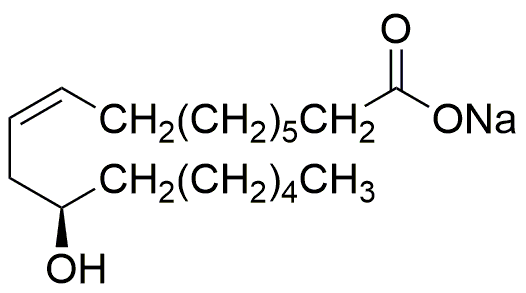Sodium ricinolate is widely utilized in research focused on:
- Cosmetic Formulations: This compound serves as an effective emulsifier in creams and lotions, enhancing texture and stability, making it a popular choice in the beauty industry.
- Pharmaceutical Applications: It acts as a surfactant in drug formulations, improving the solubility and bioavailability of active ingredients, which is crucial for effective medication delivery.
- Food Industry: Sodium ricinolate is used as a food additive, particularly in emulsifying agents, helping to blend ingredients smoothly in products like sauces and dressings.
- Biodegradable Plastics: Its properties make it suitable for developing eco-friendly plastic alternatives, appealing to industries focused on sustainable materials.
- Research and Development: In laboratory settings, it is used as a model compound to study lipid interactions and surfactant behavior, aiding advancements in material science.
General Information
Properties
Safety and Regulations
Applications
Sodium ricinolate is widely utilized in research focused on:
- Cosmetic Formulations: This compound serves as an effective emulsifier in creams and lotions, enhancing texture and stability, making it a popular choice in the beauty industry.
- Pharmaceutical Applications: It acts as a surfactant in drug formulations, improving the solubility and bioavailability of active ingredients, which is crucial for effective medication delivery.
- Food Industry: Sodium ricinolate is used as a food additive, particularly in emulsifying agents, helping to blend ingredients smoothly in products like sauces and dressings.
- Biodegradable Plastics: Its properties make it suitable for developing eco-friendly plastic alternatives, appealing to industries focused on sustainable materials.
- Research and Development: In laboratory settings, it is used as a model compound to study lipid interactions and surfactant behavior, aiding advancements in material science.
Documents
Safety Data Sheets (SDS)
The SDS provides comprehensive safety information on handling, storage, and disposal of the product.
Product Specification (PS)
The PS provides a comprehensive breakdown of the product’s properties, including chemical composition, physical state, purity, and storage requirements. It also details acceptable quality ranges and the product's intended applications.
Certificates of Analysis (COA)
Search for Certificates of Analysis (COA) by entering the products Lot Number. Lot and Batch Numbers can be found on a product’s label following the words ‘Lot’ or ‘Batch’.
*Catalog Number
*Lot Number
Certificates Of Origin (COO)
This COO confirms the country where the product was manufactured, and also details the materials and components used in it and whether it is derived from natural, synthetic, or other specific sources. This certificate may be required for customs, trade, and regulatory compliance.
*Catalog Number
*Lot Number
Safety Data Sheets (SDS)
The SDS provides comprehensive safety information on handling, storage, and disposal of the product.
DownloadProduct Specification (PS)
The PS provides a comprehensive breakdown of the product’s properties, including chemical composition, physical state, purity, and storage requirements. It also details acceptable quality ranges and the product's intended applications.
DownloadCertificates of Analysis (COA)
Search for Certificates of Analysis (COA) by entering the products Lot Number. Lot and Batch Numbers can be found on a product’s label following the words ‘Lot’ or ‘Batch’.
*Catalog Number
*Lot Number
Certificates Of Origin (COO)
This COO confirms the country where the product was manufactured, and also details the materials and components used in it and whether it is derived from natural, synthetic, or other specific sources. This certificate may be required for customs, trade, and regulatory compliance.


